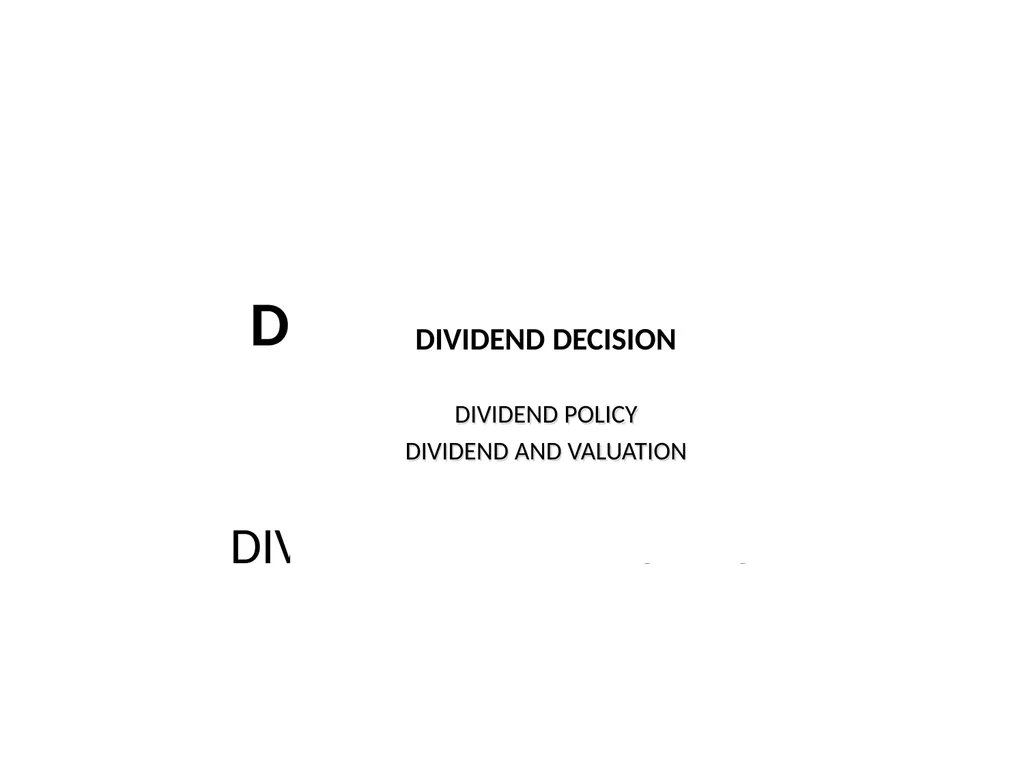DIVIDEND DECISION DIVIDEND POLICY DIVIDEND AND
Author : stefany-barnette | Published Date : 2025-05-17
Description: DIVIDEND DECISION DIVIDEND POLICY DIVIDEND AND VALUATION Share of profit distributed to shareholders Whether to distribute or not Cash or stock dividend How much of earnings to be distributed as dividend DP Ratio DPSEPS
Presentation Embed Code
Download Presentation
Download
Presentation The PPT/PDF document
"DIVIDEND DECISION DIVIDEND POLICY DIVIDEND AND" is the property of its rightful owner.
Permission is granted to download and print the materials on this website for personal, non-commercial use only,
and to display it on your personal computer provided you do not modify the materials and that you retain all
copyright notices contained in the materials. By downloading content from our website, you accept the terms of
this agreement.
Transcript:DIVIDEND DECISION DIVIDEND POLICY DIVIDEND AND:
DIVIDEND DECISION DIVIDEND POLICY DIVIDEND AND VALUATION Share of profit distributed to shareholders Whether to distribute or not Cash or stock dividend How much(% of earnings to be distributed as dividend): D/P Ratio = DPS/EPS = Divided/Earnings available for shareholders Retention ratio = 1- D/P Ratio Time : annual/interim Stability of dividend Constant DPS(5/) Constant D/P ratio Constant DPS with extra dividend Constant DPS Constant D/P ratio Constant DPS with extra dividend Advantages of stability Reduce uncertainty: market price Regular incomes Institutional investors Additional funds Determinants of dividend policy Earnings Dilution of Control Age of the company Growth needs of the firm Taxation policy Shareholders’ preference Liquidity position Inflation Contractual and legal requirements Valuation of firm and dividend Relevance theories: A) Walter’s Model B) Gorden’s Model C) Lintner’s Model: not in syllabus Irrelevance theories: MM Approach Residual theory Walter model No external financing Business risk remains constant: Current ROI(r) will remain constant, Ke will also remain constant Infinite life Conclusion: when r > Ke(growth firm) : prefer retained earnings: 100% -retention; 0% D/P Ratio(optimal) When r < Ke (declining firm) : prefer divided: 0%-retention, 100% D/P Ratio(optimal) When r = Ke (normal firm) : indifferent Walter’s Model Practical problem ABC Ltd was started a year ago with a paid-up equity capital of Rs 40,00,000.The other details are as under: Earnings of the company: 4,00,000 Dividend paid 3,20,000 Price-earning ratio: 12.5 Number of shares: 40,000 (i) Find the company’s dividend pay-out ratio. Find the market price of a share of the company at this payout ratio, using Walter’s model. (ii) Is the company’s dividend payout ratio optimal as per Walter’s model? Why? (iii) What is the market price of a share of the company at the “optimal dividend payout ratio as per the Walter’s model? Solution 100% -retention &0%D/P ratio Gorden’s Model Similar to Walter’s relevance theory: Average investor is an risk- aversers and prefers dividend distribution Growth rate (g) of the firm is the product of retention ratio(b) and rate of return (r); hence g=br =.2 *.1 = .02 = 2% Cost of capital is constant and Ke> g Gorden’s Model Practical problem Using the following, find the price of a share and value of the firm using Gorden’s Model: EPS Rs 12 Equity capitalisation rate 20% Internal rate of return 16% Retention rate 75% Number of shares outstanding 1,00,000 What will the price and value of the firm if














